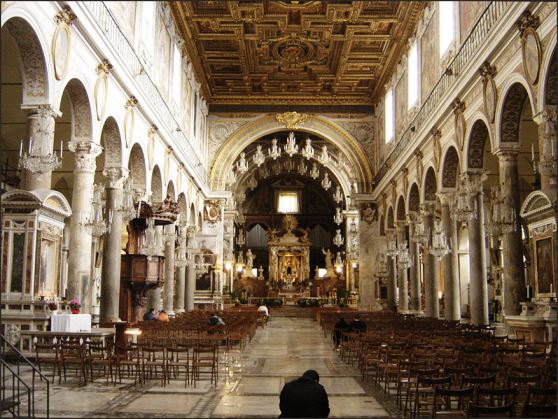| Jan 14 |
Introduction to the course: the roots of
the Christian tradition in the Hebrew Bible
Christianity is, first of all, a
tradition (or perhaps better, a stream of traditions); we all encounter
it at a particular point in the history of those traditions, and any
look at the Christianity of a particular time and place is a look at a
point in that history. The history is a definite one, and by all
accounts it begins with the collection of literature that Jesus and his
contemporaries took as the word of God. In this first class we
will be giving an overview of that literature and its place in the
development of the Christian tradition, and a quick overview of the
tradition itself.
The first class will also cover
the course requirements and other matters dealt with in this syllabus.
|
|
Jan 16 |
God, the Covenant and
the Hebrew tradition
The Exodus
The covenant
Read before class:
The
Bible: Exodus, chapters 1 through 24
|

Michelangelo, The Creation of Adam
Sistine Chapel
|
|
Jan 21 |
God, the Covenant and the Hebrew tradition
The stories of the ancestors
David, Solomon and the Temple
The Prophets
Read before class:
The
Christian Theological Tradition, chapters 1 through 5, pp. 19-89,
especially pp. 19-59
The Bible: Genesis chapters 1 through 23
|
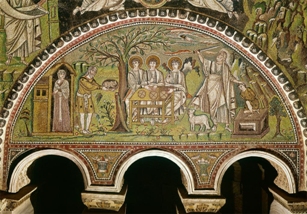
Abraham, San
Vitale, Ravenna, 6th century
|
| Jan 23 |
God, the Covenant and the Hebrew tradition
The Exile
Second Temple Judaism
|

Jerusalem |
| Jan 28 |
Jesus and the Gospels
The Gospel traditions
The Synoptic question
(On the synoptic question, click
here
for an excellent analysis of this entire question)
Read before class and post a Journal entry:
The Christian Theological
Tradition, chapter 6, pp. 91-117
Luke, chapters 1, 2, 22, 23, 24
To post a Journal entry, go to "Tools" on the Blackboard version of the
course, and click on "Journals" in that menu. Choose the Journal
for that week, and paste your entry there. Please do not "attach"
a document there; either compose it in Blackboard, or paste it from
Word.Writing
Assignment
Choose one of the online texts (the ones which appear in
blue) from this syllabus, and prepare a close
reading of that text. Your reading must include a discussion of
the historical context of that particular text: where and when was it
written? What issues does it address? What does it take for
granted? What does it say about what Christian belief means?
What influence did the text have in its time and later? The final
paper should be five to eight pages in length. You may use the
course textbook and the notes appended to the online text as part of
your study; but your paper must include your own analysis of the text on
the basis of that information. Some of the texts on the syllabus
may be more difficult than others; please check with me in person or by
email to let me know what you propose to do. An outline of your
paper is due to me by February 18; and the paper itself is due no later
than April 3.
Note that the
Resources on this syllabus can provide
you with a number of valuable sources that will help you with your
research project, although your final paper must reference both print
and online sources.
|
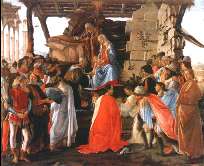
Sandro Botticelli, The Adoration of the Magi
Florence: Uffizi
|
| Jan 30 |
Jesus and the Gospels
The Gospel of John
Read before class:
John, chapters 1, 2, 13, 14, 18, 19, 20, 21 |
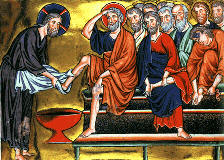
Jesus washing the disciples' feet. 13th century French |
|
Feb 4 |
Christian beginnings: first preachers
Paul and the first witnesses
Early Christian churches
Read before class and post a Journal entry:
The Christian Theological
Tradition, chapter 7
The Bible: The Acts of the Apostles, Paul's Letter to the Romans
|

The Conversion of St Paul, Caravaggio |
| Feb 6 |
Christian beginnings: first preachers
Early Christian churches and the formation of the New Testament
Read before class:
The Christian Theological Tradition, chapter 7
Letter of Pliny to Trajan on the Christians
The
Gospel of Thomas
|
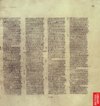
Codex Sinaiticus, a 4th century Bible |
|
Feb 11 |
Early
Christianity
Christianity and pagan
culture
Persecution
Theological questions
From persecuted sect to state religion
Read before class and post a Journal
entry:
The Christian Theological Tradition,
chapter 8
Tertullian on pagan learning
Origen on classical learning
|
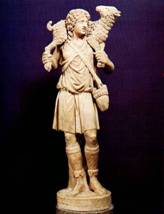
Jesus as the Good Shepherd
Rome, 3rd century
|
| Feb 13 |
Early Christianity
Persecution
Theological questions
From persecuted sect to state religion
Read before class:
The
Christian Theological Tradition, chapter 8
Other reading:
Letter of Ignatius of Antioch to the Romans
Pagan charges of ritual cannibalism
The
Martyrdom of St. Lawrence
|
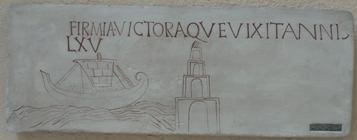
Catacomb gravestone of Firmia Victora
2nd-3rd century
|
|
Feb 18 |
The
Imperial Church
Church councils
Theology as response to philosophical inquiry
Read before class and post a Journal
entry:
The Christian Theological Tradition,
chapter 9
The Creed of the Council of
Nicaea
Other reading:
Eusebius on the conversion of
Constantine
The Edict of Milan
Term paper outline
due in class
|
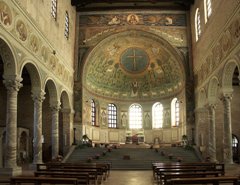
Sant' Apollinare in Classe, Ravenna
|
| Feb 20 |
The Imperial Church
Monasticism
Read before class:
The Christian Theological Tradition,
chapter 10
The
Rule of St. Benedict
Other reading:
Athanasius'
Life of
Anthony the First Hermit
Review for the Midterm Exam
|

St. Benedict delivering his Rule to his monks. Saint
Gilles Monastery, Nimes, 1129 |
| Feb 25 |
The Rise of Islam
Read before class:
The
Christian Theological Tradition, chapter 12 |
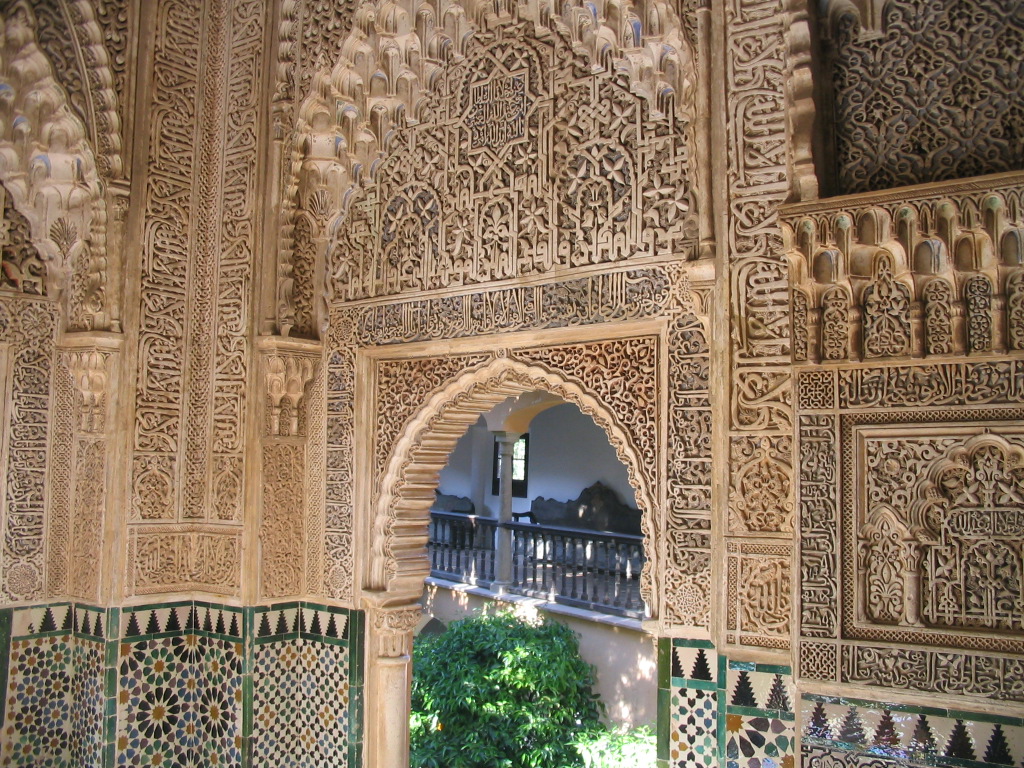
Alhambra, Granada, Spain |
|
Feb 27 |
Midterm Exam on the preceding material
|
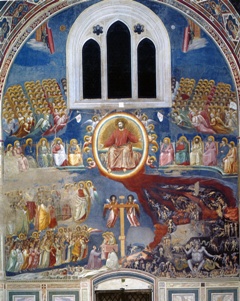
Giotto, The Last Judgment |
| Mar 4 |
Byzantine Christianity
The sacred emperor
The patriarchate
Read before class and post a Journal
entry:
The Christian Theological Tradition,
chapter 11
Other reading:
Procopius on Justinian's Church of the Holy Wisdom
(the Hagia Sophia)
|

Justinian and his court.
San Vitale, Ravenna |
| Mar 6 |
Byzantine
Christianity
The patriarchate
Byzantine monasticism
Devotion to the Virgin Mary
Icons
Read before class:
The Christian Theological Tradition,
chapter 11
Other reading:
Easter Sermon of St. John Chrysostom
Readings on Hesychasm
|
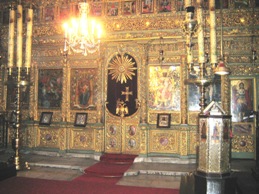
Iconostasis, St. George's
Patriarchal Church, Istanbul |
| Mar 11 |
Spring Break
- No class |
|
| Mar 13 |
Spring Break
- No class |
|
| Mar 18 |
Latin Christianity in the Early Middle Ages
Develpment of theology
Conversion of the Germanic tribes
Monasteries and bishops
Read before class and post a Journal
entry:
The
Christian Theological Tradition, chapter 13
Other reading:
The Conversion of Augustine
Vincent of Lerins' "canon"
Pope Leo I and Attila
|

Pope Leo I and Attila. Raphael, Vatican Palace
|
|
Mar 20 |
Latin Christianity in the Early Middle Ages
Monasteries and bishops
The Church in the developing feudal order
Read before class:
The Christian Theological Tradition,
chapter 13
|

Pulpit, Aachen Cathedral
Gift of Emperor Henry II in 1014 |
| Mar 25 |
Latin Christianity in the High Middle Ages
Monasteries and religious orders
Cathedral building
Read before
class and post a Journal entry:
The Christian Theological Tradition,
chapters 14 and 15
Other reading:
Description of the Abbey of Clairvaux
Bernard of Clairvaux' Apology, excerpt
Bernard of Clairvaux, On Loving God
|
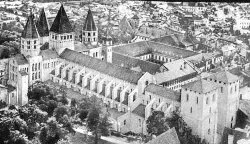
Cluny Abbey |
|
Mar 27 |
Latin Christianity in the High Middle Ages
Devotion to the Virgin Mary
Eucharistic Devotion
Pilgrimage and Crusade
Read before class:
The Christian Theological Tradition,
chapters 14 and 15
Other reading:
Thomas Aquinas on the Existence of God
The Fourth Lateran Council's Decree against heresy
|
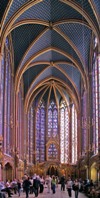
Sainte Chapelle, Paris
|
| Apr 1 |
Latin
Christianity in the Late Middle Ages
Early reforms: Francis and others
Late medieval devotional life: clergy and laity
Read before class and post a Journal entry:
The Christian Theological Tradition,
chapters 16 and 17
|
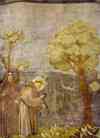
St. Francis of Assisi, by Giotto |
|
Apr 3 |
Latin
Christianity in the Late Middle Ages
Early reforms: Francis and others
Late medieval devotional life: clergy and laity
The late medieval papacy
The role of the church
The churches and the rising national states
Read before class:
The Christian Theological Tradition,
chapters 16 and 17
Term paper due at class
|

Isenheim Altarpiece, Mattias Gruenewald
|
| Apr 8 |
Reformations in the Western Churches
The churches and the rising
national states
The
question of justification
The role of the church
Luther, Calvin, Zwingli, Henry VIII and Elizabeth I
English Puritanism
Read before
class and post a Journal entry:
The Christian Theological Tradition,
chapter 18
Other reading:
Luther's Ninety-five Theses
|
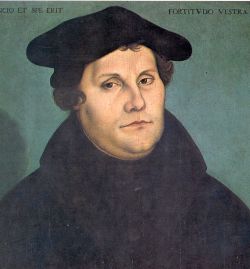
Martin Luther by Lukas Cranach
|
| Apr 10 |
Reformations
in the Western Churches
Instead of our usual class, we will meet in the Beck Rooms of the
University Library to hear a discussion on the dialogue between the
Roman Catholic and Baptist churches in the past ten years. These
ecumenical dialogues among Christian churches are a relatively new
phenomenon in Christian history, beginning about a century ago.
The differences between the Catholic and Baptist churches are
particularly strong; it is a hopeful sign that the two are talking
together after centuries of division. The two speakers will be
Catholic Bishop Arthur Serratelli of the diocese of Paterson and Dr.
Timothy George, dean of the Beeson Divinity School of Samford
University. Bishop Serratelli had been a professor at Seton Hall's
seminary before he was named bishop of Paterson. The program will
begin at 2 pm and will go beyond our normal class time, but you are
invited to stay for the whole program. |
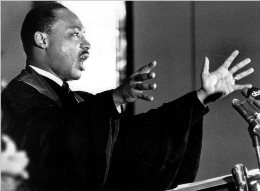
Dr. Martin Luther King preaching in Ebenezer Baptist Church |
| Apr 15 |
Roman
Catholic Christianity
St. Peter's Basilica
The Council of Trent
The Jesuit order
Read before class:
The
Christian Theological Tradition, chapters 20 and 21
Other reading:
The Creed of Pius IV (1564)
The Council of Trent on Original Sin
The Council of Trent on the Sacraments
|

The Council of Trent
|
| Apr 17 |
Holy
Thursday - University Closed |
|
| Apr 22 |
Roman
Catholic Christianity
The Jesuit order
Baroque Catholicism
Devotions
Read before class and post a Journal entry:
The
Christian Theological Tradition, chapters 20 and 21
Other reading:
From the Spiritual Exercises of Ignatius of Loyola
"Dark
Night of the Soul" of John of the Cross
|
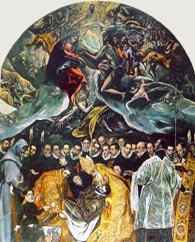
Burial of the Count of Orgaz, El Greco
Toledo, Church of Santo Tomé
|
|
Apr 24 |
European Christianity in the modern world
The
French Revolution and its aftermath
Development of Christian missions beyond the Americas
Religion as expression of national identity
Christianity and colonialism
Christianity and modern thought
Reading
before class:
The Christian Theological Tradition,
chapter 22
|

The galaxy Abell 370, photographed by the Hubble telescope
in 2009 |
|
Apr 29 |
American Christianity
Puritans and Cavaliers
Established churches and the First Amendment
Roman Catholic immigration
The
First Vatican Council
Read before
class:
The Christian Theological Tradition,
chapter 23
|

St. Patrick's Cathedral, New York City |
|
May 1 |
Review for
Final Examination
|
|
May 13
2:30-4:30pm
|
Final
Examination
|
